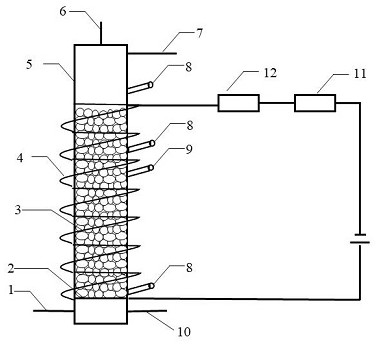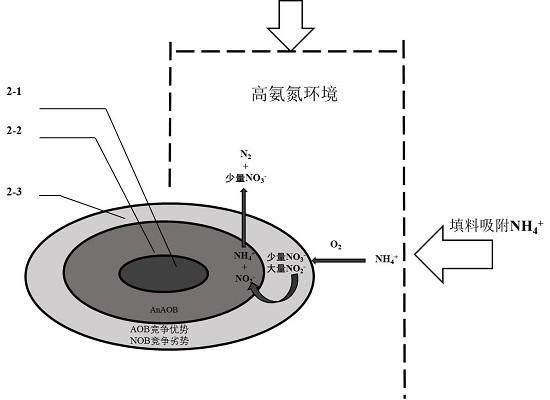Low-temperature low-ammonia-nitrogen sewage denitrification device based on magnetocaloric effect coupling carrier
A magnetocaloric effect, low ammonia nitrogen technology, applied in the field of sewage biological denitrification treatment, can solve the problems of low activity of AOB and AnAOB, increased energy consumption, unstable bacterial flora, etc.
- Summary
- Abstract
- Description
- Claims
- Application Information
AI Technical Summary
Problems solved by technology
Method used
Image
Examples
Embodiment 1
[0033] This embodiment relates to a low-temperature low-ammonia-nitrogen sewage denitrification device based on a magnetic-caloric effect coupling carrier, and its specific structure is as follows figure 1 Shown:
[0034] Including the sewage treatment container 5, the magnetic heat carrier 3 in the sewage treatment container 5, and the magnetic field generating device outside the sewage treatment container 5; a water inlet 1 and an air inlet 10 are arranged at the bottom of the sewage treatment container 5, The upper part of the processing container 5 is provided with a water outlet 7 and an air outlet 6; the magnetic heat carrier 3 is loaded with nano-Fe 3 o 4 Zeolite has anammox bacteria and nitrosative bacteria growing on its inside and surface.
[0035] In this embodiment, the sewage treatment container 5 is made of plexiglass.
[0036] In this example, the magnetic heat carrier 3 is prepared according to the scheme disclosed in CN201510157695.9, and the particle size ...
Embodiment 2
[0042] The specific application of the low-temperature low-ammonia-nitrogen sewage denitrification process based on the magnetocaloric effect coupling carrier involved in the embodiment, the steps are as follows:
[0043] 1) Pass the sewage with ammonia nitrogen concentration of 45-50 mg / L and chemical oxygen demand COD concentration of 40-50 mg / L into the sewage from the lower water inlet to control the hydraulic retention time from 0.25-1.25h until the effluent ammonia nitrogen is ≥5mg / L L is to stop water intake, empty the sewage treatment container, and complete the initial ammonia nitrogen adsorption;
[0044]2) Add the sludge containing AnAOB, AOB, and NOB three functional bacteria from the upper part of the sewage treatment container into the reactor filled with magnetic heat carrier, and promote the uniform mixing of microorganisms and magnetic heat carrier through aeration and sewage flow , maintain the dissolved oxygen DO concentration at 0.5-1.0 mg / L, turn on the ma...
Embodiment 3
[0048] This embodiment relates to the distribution of AOB, AnAOB, and NOB inside and on the surface of the magnetic heat carrier and its specific treatment process for ammonia nitrogen in sewage.
[0049] Such as figure 2 As shown, the nano-Fe loaded by the magnetothermal carrier 3 o 4 Under the action of the external medium-high frequency alternating magnetic field, the heating effect is generated due to the Neil relaxation phenomenon, creating a local high-temperature microenvironment, creating a suitable temperature microenvironment for AnAOB with the optimum growth environment temperature of 30-35°C, improving microbial activity and Form a competitive advantage; on the other hand, because the temperature environment of 30-35 ° C is conducive to AOB winning in the competition with NOB, the accumulation rate of nitrite nitrogen is improved, and the growth of AnAOB is provided with sufficient reaction substrate, which promotes the growth of AnAOB. grow. Zeolite efficientl...
PUM
| Property | Measurement | Unit |
|---|---|---|
| particle diameter | aaaaa | aaaaa |
| particle diameter | aaaaa | aaaaa |
Abstract
Description
Claims
Application Information
 Login to View More
Login to View More - R&D
- Intellectual Property
- Life Sciences
- Materials
- Tech Scout
- Unparalleled Data Quality
- Higher Quality Content
- 60% Fewer Hallucinations
Browse by: Latest US Patents, China's latest patents, Technical Efficacy Thesaurus, Application Domain, Technology Topic, Popular Technical Reports.
© 2025 PatSnap. All rights reserved.Legal|Privacy policy|Modern Slavery Act Transparency Statement|Sitemap|About US| Contact US: help@patsnap.com


